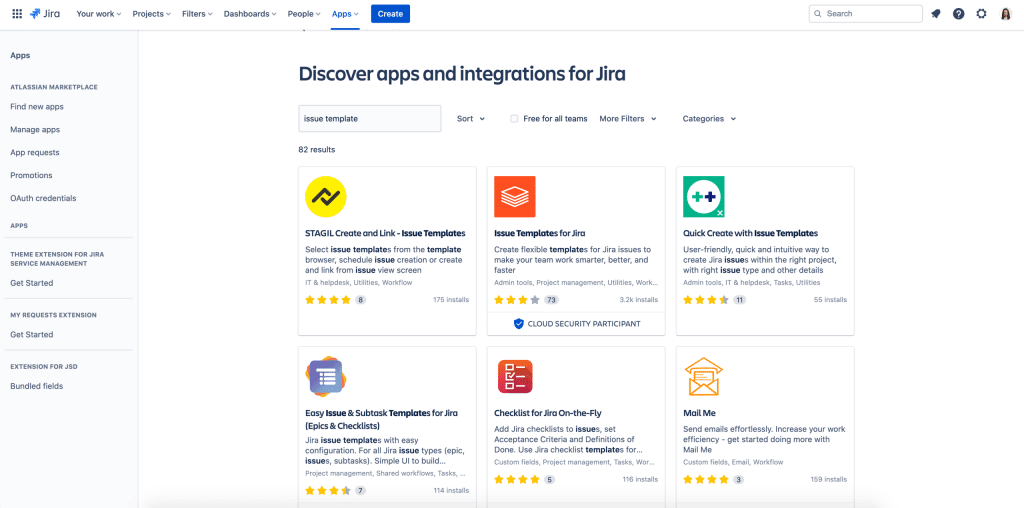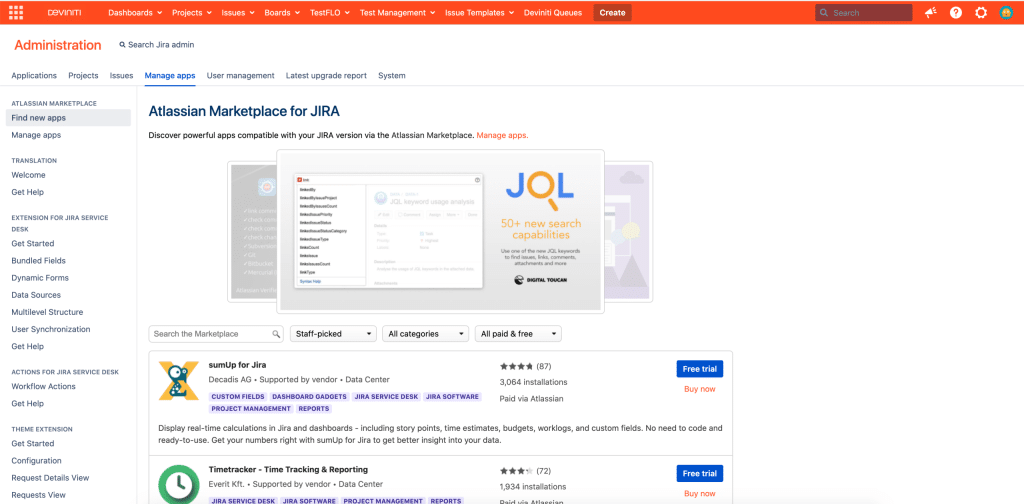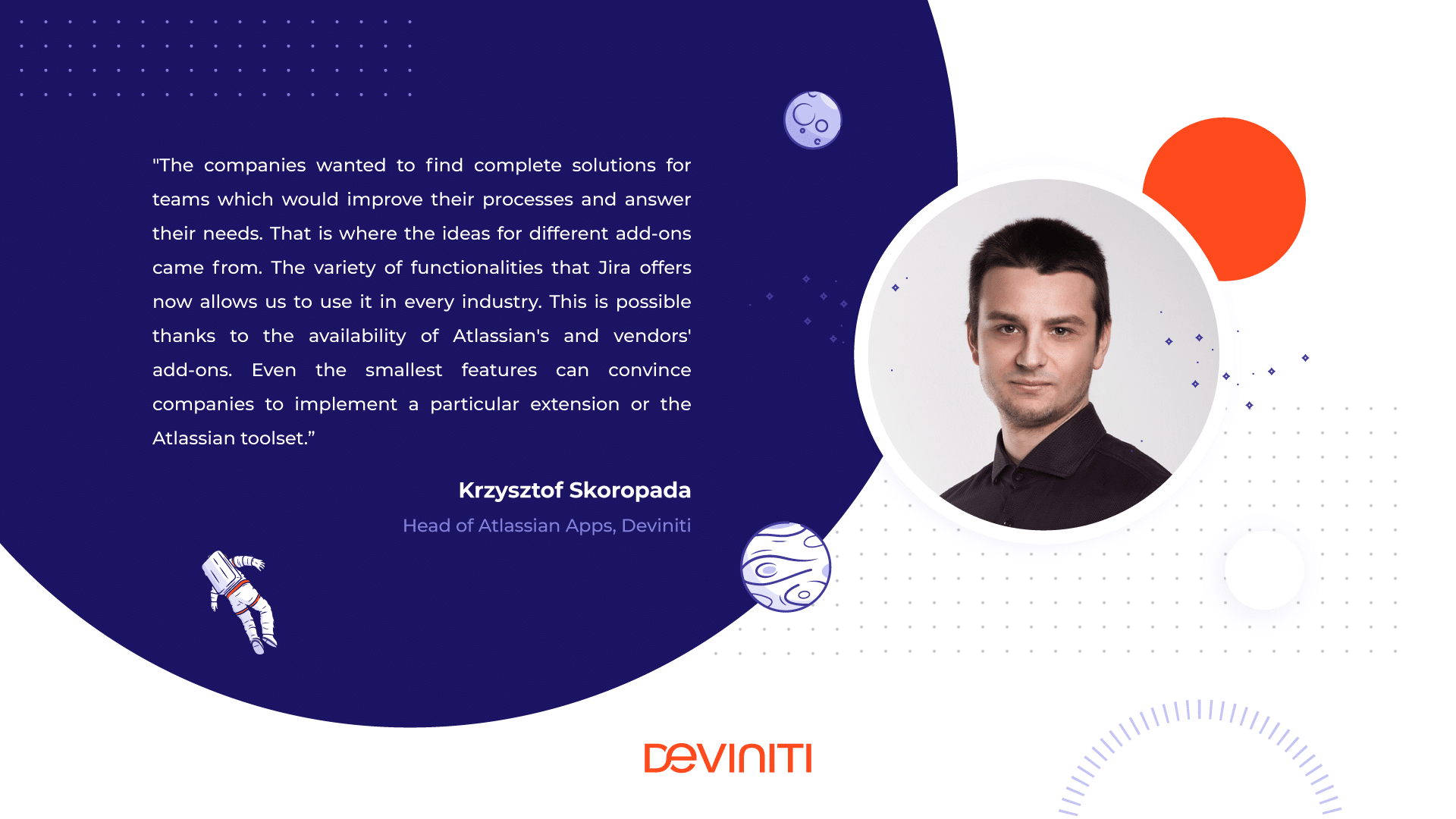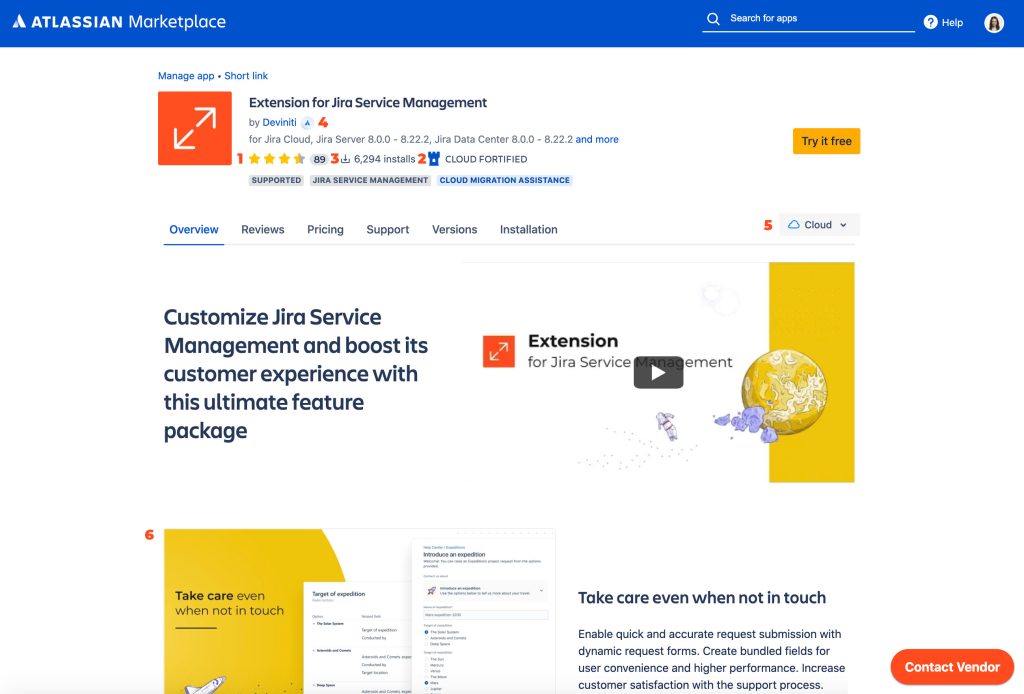Devinitive guide to choosing the Atlassian Marketplace Apps

Updated 27.05.2022
No matter if you’re looking for the next app to enhance your Jira or happened upon this article because you’re searching for the first extension in your life and you have no idea how to choose a perfect solution from loads of apps. We’re sure that in both cases there are aspects you may need some help with since there are over 4000 apps available in the store. That’s why we’d like to show you around the Atlassian Marketplace, which we’ve been a part of since its launch. Don’t worry, we won’t be stopping by every exhibit. We’re taking you on an educational path that includes only specific information about apps’ selection factors, apps’ categories, vendors and listings. Will you join along?
Point Zero: What is the Atlassian Marketplace?
The Atlassian Marketplace is a platform where you can find, download and buy apps for Atlassian products like Jira Software, Jira Service Desk, Confluence, Bitbucket, Crucible, Fisheye, Bamboo, Crowd and Trello. The apps have been developed by different vendors from all over the world. The name “app” is used in the Ecosystem for the solutions which extend Atlassian software with new features to meet different businesses’ specific needs. Within the Ecosystem’s history, different names were used (like add-ons, plugins, and extensions), and now apps are the official name (but in this text, we’re using all of them interchangeably).
The Atlassian’s solutions include loads of useful functions which may be enough for many companies. However, if your requirements go beyond them, you don’t have to switch to another tool. You can just choose an app for one of the products and increase your return on investment for the whole toolset. It’s as simple as that.
First station: Jira Marketplace history
Time for history. Add-ons were part of Atlassian’s identity even before the Marketplace launch. Back then, the extensions existed on the Atlassian’s page called Plugins. The first one we published there was Conditions Validator, now known as Help (a.k.a. Conditions Validator). Everyone could add an app on that platform, and the majority of them were free. In case of paid extensions, the payment had to be done separately through the particular partner’s site.
In May 2012, Atlassian made users’ life easier by introducing a platform where you could browse all apps, start a free trial and make a purchase – all through the same website! Paid via Atlassian option enabled customers to get an app through the official sales platform as easily as the Atlassian software itself. The users also got the opportunity to search for add-ons inside the products like Jira, thanks to the Universal Plugin Manager. It’s a tool for managing apps in Atlassian applications, which allows you not only to find the apps but also install, manage, and configure them. To use the UPM you need to have the Jira admin’s permissions. If you do, you can access the tool going to Jira Settings → Find new apps or Manage apps in Jira Cloud or clicking Jira Administration → Manage apps in Jira Server. Note that the search results are filtered by the apps compatible with your Jira version.
Other positive changes that the new platform brought were a better layout and clearer listings. On the vendor’s part, Marketplace increased its interest in add-ons and visibility to the extensions. Moreover, it also gave their creators a chance to spread their ideas to the world.
Atlassian’s decision to build an ecosystem of partners and vendors was a driving force for many companies all over the world. They started thinking about what to add to Atlassian software to adjust ecosystem to the needs of different industries.
Second station: Homepage
Welcome to the heart of the Atlassian Marketplace. Here you get a lot of useful tools for your app search. Generally, the homepage is divided into five sections which give you different ways of exploring the platform. You can take the Discover new apps path and browse the category pages featured from the Categories section (located on the left side panel). On every page, the add-ons are ranked automatically, based on the number of active installs, star rating, and recency of publication.
Other trails that you can walk along are:
- The Top-selling apps route leads you through the add-ons which have had the highest total dollar sales in the last 30 days;
- The Newest apps trail features most recently published extensions (counted from the approval date);
- The Trending apps trail presents you with the add-ons which have reached the most active installations within the last 7 days;
- The Cloud Fortified route simply shows apps that joined this program.
You can also see the Staff picks section with the apps highlighted by the ecosystem’s team. Here only a few apps are visible, but by browsingdifferent categories and sections, you’ll notice the label Staff pick next to different apps on the results list.
All featured add-ons meet the requirements specified by Atlassian. It means that these apps are free or offer the paid via Atlassian option, are supported, and have a high overall rating as well as a big number of installs. The extensions’ vendors also have an established track record of success with customers. The apps with the Staff pick label not only fulfill the mentioned requirements but also are available on multiple hosting options.
Now let’s take a look at the left side panel which contains very practical filters. By using them, you can narrow down the results visible on the homepage. For example, imagine you’re looking for a top-rated Jira Cloud extension that is free and deals with reports. When you’re choosing the needed filters, the results change dynamically.
As you’ve probably already noticed in the example, you can filter the results by the product. Jira Service Management, Confluence, and Jira Software add-ons dominate here, but there are quite a few solutions for other Atlassian software as well. Then you have a significant filter – the hosting options, and the real treasure – categories. There are around 40 different groups of apps to choose from. Remember also to click on more filters to display some other options like Marketplace Partner Program (formerly Top Vendor). It is a program created for helping users buy extensions with confidence. The vendors selected for it have to meet the Atlassian benchmark for app traction, timely support, and vendor reliability. You can recognize such vendors by the Marketplace Partner badge which is located next to their companies’ names on the app’s listing.
That’s not all. According to Atlassian’s journey to the Cloud, some of the Cloud apps from Marketplace are available for free. The offer is dedicated to small teams of up to 10 users and includes all Cloud apps by Deviniti and Hexygen. Thanks to that, even the smallest team can use fully professional tools and improve their further development. You can easily find those apps using a filter Free up to 10 users.
Third station: Listings
Now that we know the heart of the Marketplace, let’s take a closer look at its soul – the app listing pages. They include a lot of helpful information which we’d like to elaborate a little bit more on.
Overview
Before we start our journey through the different tabs of the app page, we’ll decipher the website’s upper part. The stars on the right of the add-on’s logo (1) tell you how other users rated it, and the number located next to them means the number of reviews (3). Also, don’t skip over the number of active installs (2) which you’ll find below because it helps you rate the extension’s popularity. Right under the app’s name, you can see the Marketplace Partner badge (4)as well as the Atlassian product and its versions the add-on matches with. Another useful piece of information is whether the app is supported by the vendor. This may be important for you if you plan to use the chosen extensions for your crucial business processes. This section also contains the information whether the app is a Cloud Security Participant and/or Cloud Migration Participant.
We’re sure that while opening the app’s listing your sight stopped at the screenshots or promo video (6). However, their presence is not enough to attract somebody’s attention. The best visuals should stand out with their aesthetics and quality. They should also present the add-on in action, give you a sneak peek of its usability and core features, as well as answering the question: How does this extension work with Jira? Screenshots aren’t the only graphic materials you can find in the Overview tab. Some vendors also place there the app’s tutorials along with additional screen captures from the add-on in the Gallery section (7).
More details
This section provides you with additional information about the app and its features. You can also find here useful links to articles, case studies, or the app’s documentation.
Certification
This section appears for Cloud apps that have joined the Cloud Fortified program. To join this program, the application must meet several security, reliability, and privacy requirements that have been established by Atlassian. You can find detailed guidelines in the documentation. This information might be important, especially for large companies and industries in which security and data protection are crucial, e.g., medical industry, military, and banking.
Privacy and security
In this part of the Overview tab, you can find a link to the vendor’s privacy policy. Additionally, Cloud app pages also contain a Security section which shows whether the vendor completed the security self-assessment and shared the results with Atlassian. Here you can also find the information about participation in the Marketplace Bug Bounty program.
To maximize the app security, Atlassian gave Marketplace Partners the opportunity to discover vulnerabilities of their apps and providing customers with much more secure solutions. Add-ons that joined the Marketplace Bug Bounty program are tested by skilled security researchers. As a result, Marketplace Partners can easily find and fix vulnerabilities in their apps on an ongoing basis.
Resources
Although this section is located almost at the bottom of the Overview tab, it’s very important for the users. Here you can download the app andaccess Version history, Documentation, or EULA. The last one stands for the End User License Agreement and by clicking on it, you get to the place with the vendor’s legal documentation. It can contain the app license details, terms of purchase, and the Service Level Agreement (what the support does and doesn’t include). In this section, you can also find more information about Cloud migration: Cloud migration pathway and Feature Parity Comparison.
Watch app, the last link in the Resources section, lets you sign up for email alerts, which include release notes. This is a perfect option when you’re interested in some extension but don’t need it in the particular moment, or when you’re waiting for some features which are necessary for your business process.
Reviews
By reading the reviews, you can check not only what other users think about a particular extension but also how its support team answers the comments. Look especially at the negative feedback and new feature suggestions. It will show you if the vendor cares about the users’ comments, replies to them quickly, adjusts the product to their needs, and encourages further contact via email or support pages.
Pricing
App prices are set by the vendors and iffer between Cloud and Data Center versions. Buying an add-on for Jira Cloud, you can select the monthly or annual subscription. Data Center apps are sold as a perpetual license, and the purchase price includes 12-month maintenance (support and version updates). You can learn more about the cost in the Pricing FAQ located in the Pricing tab of every extension page.
On Cloud apps listings, there is a calculator that helps in better cost estimation. The only data you need to provide is the number of users and the subscription type (monthly or annual).
Please note that the apps are billed based on the user tier of your Jira (the maximum number of users you’ve paid for when purchasing a license), not on the number of Jira Service Management agents or the number of the real users of a particular app.
Support
Here you can see the support hours and the vendor’s contact details. You can contact the company to ask questions about the app. To get more information, you can also click on Documentation. Some vendors have the contact support widget visible as a button in the lower-left corner of their apps’ pages. When you click on it, a request form, powered by Jira Service Desk, appears. It facilitates asking questions to the support team and shows that the vendor comes up to the clients’ expectations like a need for fast and easy to find contact options.
Versions
In this tab, you can see supported Atlassian product versions and the latest releases’ details. By clicking on See all versions, you’ll get the releases’ details. It’s important to visit this page to know if your Atlassian Software is compatible with the app. Some vendors (including ourselves) offer separate release packages for Jira Data Center. When downloading the app, take notice whether you have chosen the right installation package.
The all versions option also shows you the frequency of new releases and bug fixes. This way you’ll know if the app is still updated and developed.
The upper solution works for Data Center hosting. In the case of Cloud, the description is available for the latest release only when the descriptor has been changed. You need to update the app in Jira through the “Manage apps” section. If the descriptor remains the same, the app is updated automatically and does not require taking any other actions.
Hosting options switcher
The app you found can be available for different hosting options. Note that the versions for Cloud, Server and Data Center can vary. To switch between the versions, use the select bar (5) located in the upper left part of the app page.
According to Atlassian’s plan to quit Jira Server by 2024, we strongly recommend choosing another hosting type to build your infrastructure or migrate to Cloud or Data Center in advance. If you need more information or have any further questions, feel free to ask – our experts are here to help.
Check out our comprehensive eBook about Jira!
Download our Jira: Essential Guide for Beginners ebook and learn how to make the most of your project management tool, even if you’re just at the very beginning of your journey!
Final station: choosing an app from the Atlassian Marketplace
On different stations of our educational trail, you got some tips on what to look at while selecting the best Jira add-ons from the AtlassianMarketplace. However, there are still a few more things that will make your research easier. We prepared graphics together with explanations (where needed), so you can come back to this part of our guide every time you want to buy an extension from the Jira plugin marketplace.
Read the app documentation
Documentation, tutorials, and other educational content created by the vendor should be one of the key parameters you check before purchasing an app. Look for the place where the vendor stores the documentation – it may be a Confluence space, the company’s website, or another form of a knowledge base. Check if the instructions are clear to you, all plugin functionalities are covered, and the content is regularly updated.
Check other apps developed by the vendor
Browsing other apps of the vendor can give you more information about the company and user satisfaction with the products. This can build up your trust toward the vendor as well as purchase confidence.
Watch product demos
It’s crucial to see the app in action before buying it. Some vendors give a possibility to sign up for a demo session, whereas others have demo videos on their YouTube channels. Also, don’t forget to visit the vendors’ blogs which usually contain educational content, tips and tricks as well as articles that compare specific apps.
Start a free trial
Use the possibility to evaluate the app. Most of the Atlassian store vendors offer a fully functional trial license. You have 30 days to test the plugin on your test instances (so that you don’t have to conduct risky experiments on the production instances).
Evaluate the vendor’s support service
You can contact a support team through email or the Service Desk to see how fast they answer and how their assistance process works. A good support agent should:
- provide you with comprehensive information,
- communicate in a “human” way (so that you won’t have a feeling that you’re talking with a bot),
- try to build a relationship with you,
- show interest in your experience with the product,
- be open to receiving new feature suggestions.
Ask Atlassian Community and your local solution partner
The Atlassian Community is large (it has grown from zero users to three million in three years) and gathers the users who want to help each other. You can search it for app reviews and case studies through keywords, post your question about the add-on, or start a discussion.
Gal Fatal, DevOps team manager in HP and Tel-Aviv Atlassian User Group leader, recommends engaging with a local community as well. You can talk about the solution you need with a local Solution Partner. They can help you with everything from the license management, through complete implementation of the Atlassian products and apps, up to different integrations and migrations. The Solution Partner is also able to create a custom plugin for you if there’s no solution on the Marketplace that meets your needs or requirements.
Join Atlassian User Group meetings
Gal Fatal also encourages you to check if there’s an Atlassian User Group (the name has recently changed to Atlassian Community) in your city and join one of their meetings. This way, you’ll gain more information about Atlassian products and Marketplace apps, as well as having a chance to ask your questions. All attendees of Atlassian Community meetings are happy to share their knowledge.
Meet vendors at the events like the Atlassian Team ’22
Live events are perfect opportunities to talk with vendors about your business needs and schedule product sessions. Atlassian used to host the Summit once a year, but in 2022, the event evolved into Atlassian Team ’22. Deviniti has also been there this year and we will be happy to share some memories from Vegas with You.
Don’t worry! There’s no need to schedule a trip to the USA to become a part of the Atlassian community. Have you ever heard about Jira Day – the largest Atlassian conference in Central Europe which will take place in Poland? After two years of conducting the conference online, in 2022, we finally can meet again during the stationary event. Feel free to join us and explore the galaxy of possibilities!
There is a plugin for that
Our journey through the Jira Marketplace is coming to an end, but your adventure with the apps has just begun! Don’t rush through. Take your time to check if any apps that you have meet your needs. If the answer is “no”, write down the requirements you have for the future plugin and start browsing the Atlassian store. Enjoy your trip!
If you still don’t know where to start your journey through the Atlassian Marketplace, we strongly encourage you to check our space first!
Explore Atlassian Marketplace
Start your journey with Deviniti space










